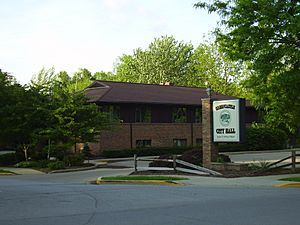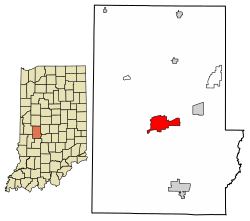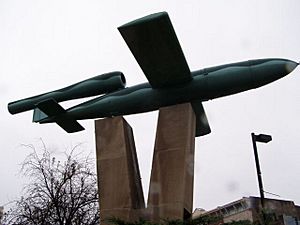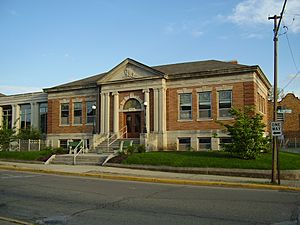Greencastle, Indiana facts for kids
Quick facts for kids
Greencastle, Indiana
|
|
|---|---|
| City of Greencastle | |

City hall
|
|

Location of Greencastle in Putnam County, Indiana.
|
|
| Country | United States |
| State | Indiana |
| County | Putnam |
| Township | Greencastle |
| Government | |
| • Type | Mayor–council |
| Area | |
| • Total | 5.26 sq mi (13.63 km2) |
| • Land | 5.21 sq mi (13.50 km2) |
| • Water | 0.05 sq mi (0.13 km2) |
| Elevation | 837 ft (255 m) |
| Population
(2020)
|
|
| • Total | 9,820 |
| • Density | 1,884.11/sq mi (727.40/km2) |
| Time zone | UTC-5 (EST) |
| • Summer (DST) | UTC-4 (EDT) |
| ZIP code |
46135
|
| Area code(s) | 765 |
| FIPS code | 18-29358 |
| GNIS feature ID | 2394980 |
| Website | http://www.cityofgreencastle.com |
Greencastle is a city in Putnam County, Indiana, United States. It is the main city, also known as the county seat, of Putnam County. You can find Greencastle near Interstate 70, about halfway between Terre Haute and Indianapolis. This city is also home to DePauw University. In 2020, about 9,820 people lived in Greencastle.
Contents
History of Greencastle
Greencastle was started in 1821 by a person named Ephraim Dukes. He received a special land grant to create the settlement. He decided to name it after his hometown, Greencastle, Pennsylvania.
For many years, Greencastle was a small village or town. It was managed by the Putnam County leaders. On March 9, 1849, it officially became a town. Later, on July 8, 1861, Greencastle, Indiana, became a city after a special election. The first mayor of Greencastle was E. R. Kercheval. The city also became the main city, or county seat, for Putnam County.
The 1933 Bank Robbery
In 1933, a famous bank robber named John Dillinger and his group robbed the Central National Bank in Greencastle. This was one of six banks he robbed in Indiana. They got away with a large amount of money, which was a very big deal at the time. This event became one of the most talked-about moments in Greencastle's history.
Exploring Historic Places
Greencastle has three old neighborhoods that are very special. These are Old Greencastle, the Eastern Enlargement, and the Northwood Neighborhood. They were added to the National Register of Historic Places in 2011. This means they are important places in history.
The city also has 20 other historical sites listed on the National Register of Historic Places. Some of these include The Appleyard, The Boulders house, Brick Chapel United Methodist Church, and East College of DePauw University. These places help tell the story of Greencastle's past.
Geography and Climate
In 2010, Greencastle covered about 5.29 square miles (13.7 square kilometers). Most of this area, about 5.24 square miles (13.57 square kilometers), is land. A small part, about 0.05 square miles (0.13 square kilometers), is water.
Greencastle's Climate
Greencastle has a humid continental climate. This means the weather changes a lot between seasons. Summers are usually warm to hot and often humid. Winters are cold, and sometimes very cold. This type of climate is known as "Dfa" in the Köppen Climate Classification system.
| Climate data for Greencastle, Indiana | |||||||||||||
|---|---|---|---|---|---|---|---|---|---|---|---|---|---|
| Month | Jan | Feb | Mar | Apr | May | Jun | Jul | Aug | Sep | Oct | Nov | Dec | Year |
| Mean daily maximum °C (°F) | 2 (36) |
4 (40) |
11 (51) |
17 (63) |
23 (74) |
28 (83) |
30 (86) |
29 (85) |
26 (79) |
19 (67) |
11 (52) |
4 (39) |
17 (63) |
| Mean daily minimum °C (°F) | −7 (19) |
−6 (21) |
−1 (31) |
6 (42) |
11 (51) |
16 (61) |
18 (64) |
17 (62) |
13 (55) |
7 (44) |
1 (33) |
−5 (23) |
6 (42) |
| Average precipitation mm (inches) | 69 (2.7) |
58 (2.3) |
97 (3.8) |
97 (3.8) |
120 (4.7) |
120 (4.8) |
110 (4.2) |
94 (3.7) |
94 (3.7) |
76 (3) |
86 (3.4) |
76 (3) |
1,090 (43.1) |
| Source: Weatherbase | |||||||||||||
Population and People
| Historical population | |||
|---|---|---|---|
| Census | Pop. | %± | |
| 1850 | 1,382 | — | |
| 1860 | 2,096 | 51.7% | |
| 1870 | 3,227 | 54.0% | |
| 1880 | 3,644 | 12.9% | |
| 1890 | 4,390 | 20.5% | |
| 1900 | 3,661 | −16.6% | |
| 1910 | 3,790 | 3.5% | |
| 1920 | 3,780 | −0.3% | |
| 1930 | 4,613 | 22.0% | |
| 1940 | 4,872 | 5.6% | |
| 1950 | 6,888 | 41.4% | |
| 1960 | 8,506 | 23.5% | |
| 1970 | 8,852 | 4.1% | |
| 1980 | 8,403 | −5.1% | |
| 1990 | 8,984 | 6.9% | |
| 2000 | 9,880 | 10.0% | |
| 2010 | 10,326 | 4.5% | |
| 2020 | 9,820 | −4.9% | |
| U.S. Decennial Census | |||
What the 2020 Census Shows
In 2020, the census counted 9,820 people living in Greencastle. There were 3,446 households, which are groups of people living together. The city had about 1,884 people per square mile (727 per square kilometer).
Most people in Greencastle, about 88.9%, were White. About 5.5% were Asian, and 1.8% were African American. About 2.7% of the population identified as Hispanic or Latino.
The average household had 2.10 people. About 18.2% of the people were under 18 years old. Also, 14.5% were 65 years old or older. The population was almost evenly split between males (49.4%) and females (50.6%).
What the 2010 Census Showed
The 2010 census counted 10,326 people in Greencastle. There were 3,368 households. About 30.9% of these households had children under 18 living there.
The average age of people in the city was 27.4 years. About 19% of residents were under 18. A large group, 28.5%, were between 18 and 24 years old, likely including many college students.
Culture and Fun Activities
Greencastle is a lively place with many festivals and cultural spots. You can enjoy the Greencastle Music Fest and the Downtown Greencastle Farmers' Market. There's also First Friday Greencastle and the Monon Bell Football Game. Music on the Square and the Putnam County 4-H Fair are popular events too. The Richard E. Peeler Art Center and the Putnam County Playhouse offer arts and entertainment.
Parks and Outdoor Spaces
The city has several parks and places for outdoor fun. These include Big Walnut Sports Park, DePauw University Nature Park, Jaycee Park, and Robe Ann Park. Greencastle also has "People Pathways," which are trails and paths around the city. These paths even connect to nearby communities, making it easy to walk or bike around.
Education and Learning
Greencastle offers many ways to learn, from public schools to colleges and libraries.
Public Schools
Greencastle's public schools are managed by the Greencastle Community School Corporation. The school system includes:
- Greencastle High School (grades 9-12)
- Greencastle Middle School (grades 6-8)
- Tzouanakis Intermediate School (grades 3-5)
- Martha J. Ridpath Primary School (kindergarten-2nd grade)
- Deer Meadow Primary School (kindergarten-2nd grade)
Private Schools
Peace Lutheran School is a private school in Greencastle. It started as a preschool in 1984. Over the years, it added more grades. As of 2011, it teaches students from kindergarten through 6th grade.
Colleges and Universities
DePauw University is a private college known for its liberal arts programs. It was founded in 1837 as an all-men's school. In 1867, four women became the first female students, including Bettie Locke Hamilton, who helped start America's first college women's fraternity.
Today, DePauw has about 2,400 students from many different states and countries. The college often ranks among the top liberal arts colleges in the United States.
Ivy Tech Community College is a large community college system in Indiana. A modern Ivy Tech campus was built in Greencastle in 2009. The Putnam County Community Foundation helps support this campus.
Other Learning Places
Greencastle is home to the Putnam County Public Library. This library serves people from Putnam County and nearby areas. It offers books, movies, music, and computer access. They also have programs for all ages and a special section for local history and family research. Since 2017, the library has an adult literacy program called PALS. They even have a PALS Pups program where children can read to trained "good citizen" dogs! The library building was originally a Carnegie Library, built in 1903, and was expanded in 1996.
Greencastle also has The William Weston Clarke Emison Museum of Art. This building was once a municipal Carnegie library and later became a museum in 1986. It was named after James W. Emison, who helped the university a lot. The building was built in 1908 and was originally the campus library for DePauw University.
The Putnam County Museum has a collection of nearly 2,000 items related to Putnam County's history. It shows what life was like in the past and the county's role in events like the Civil War. The museum also features art from local artists in changing exhibits.
Notable People from Greencastle
Many interesting people have connections to Greencastle:
- William Atherton (1793-1863), a soldier.
- Charles A. Beard (1874-1948) and Mary Ritter Beard (1876-1958), famous American historians.
- Samuel T. Busey (1833-1909), a Civil War general and politician.
- Eli Lilly lived in Greencastle for several years and opened a drugstore there in 1861. He later founded the well-known pharmaceutical company, Eli Lilly and Company.
- Tad Robinson (born 1956), a blues singer.
- Jesse W. Weik (1857-1930), who wrote a biography about Abraham Lincoln.
See also
 In Spanish: Greencastle (Indiana) para niños
In Spanish: Greencastle (Indiana) para niños



